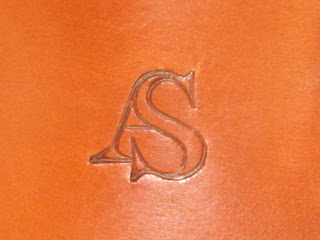After having a chance to see Alfred Sargent's Exclusive line in person at the MRket show back in January, Chay Cooper was kind enough to send me a pair of adelaide brogues in chestnut calf leather (in the interest of full disclosure, the shoes were made available to me at a significantly reduced price). The model is known as the Moore and, to put it simply, the shoes are impressive in several ways.
Some of you will probably find this hard to believe, but the adelaide brogue represented a heretofore unfilled gap in my shoe collection. I'd been looking for something along the lines of the Moore for some time, and of course I'd been hearing about Alfred Sargent's Exclusive line from satisfied customers for awhile now as well.
To begin with, Mr. Cooper's aesthetic sensibilities are readily apparent in the Exclusive line. I was particularly intrigued by the narrow waist on the sole - quite frankly, I don't think I've ever seen a ready-to-wear shoe with such an elegantly tapered appearance -Gaziano & Girling's Deco line being the only thing that came to mind. Looking down at the shoes once they're on your feet, the silhouette is really quite unique. I think this has to do with how the sole edge is literally tapered at the waist - creating a visually appealing effect.


At first glance, I was concerned that the shoes might be too narrow at the heel or along the waist, but my concerns were unfounded. I had chosen the wider "F" width, and this worked out very well. If anything, the width of the shoe at the ball of the foot probably has a bit more room than I've grown accustomed to in new shoes, but this isn't to say that the shoe is ill-fitting. The toe box was actually quite comfortable. And the rest of the shoe fits quite well, especially at the heel (which fits quite snug, which I like).
Of course, the trade-off is that the narrower "E" fitting might have had less room at the ball of the foot but would have instead been tighter at the heel and along the waist. With all of this in mind, I decided to put the shoes to the test and hit the streets (i.e. wear them to work). The shoes were very comfortable, and I didn't notice any slippage or discomfort while walking.

All in all, I found the finishing on the leather uppers and soles to be very well done. The chestnut calf leather has a deep, rich brown color. There is some slight burnishing at the toe box and the back quarters, but its quite subtle and a welcome diversion from the more overt efforts that you see on the market these days.The adelaide throat is distinct and also a nice change from the more typical style that I'm used to wearing. I'm also becoming a fan of the understated elegance of the captoe sans medallion. The brogue design along the back quarters offers yet another eye-catching example of Alfred Sargent's clean punching and stitching. And, of course, the inherent beauty of the solework - evident in the narrow, curved waist and channeled soles - is plain for all to see.


For a shoe that retails at roughly GBP 400, I would compare the Exclusive line quite favorably to Grenson Masterpieces (made for Paul Stuart's Stuart's Choice line) and Crockett & Jones' Handgrade line. I would also say that the shoes offer very good value vis-a-vis some of the other Northampton manufacturers in the GBP 600-800 price range.






.JPG)
.JPG)
.JPG)
.JPG)
.JPG)
.JPG)
.JPG)
.JPG)











.JPG)
.JPG)
.JPG)
.JPG)
.JPG)


